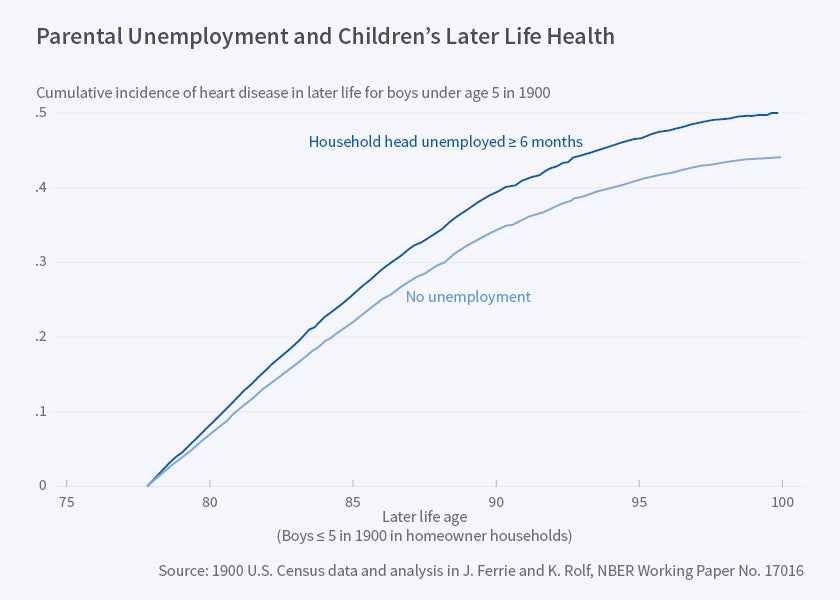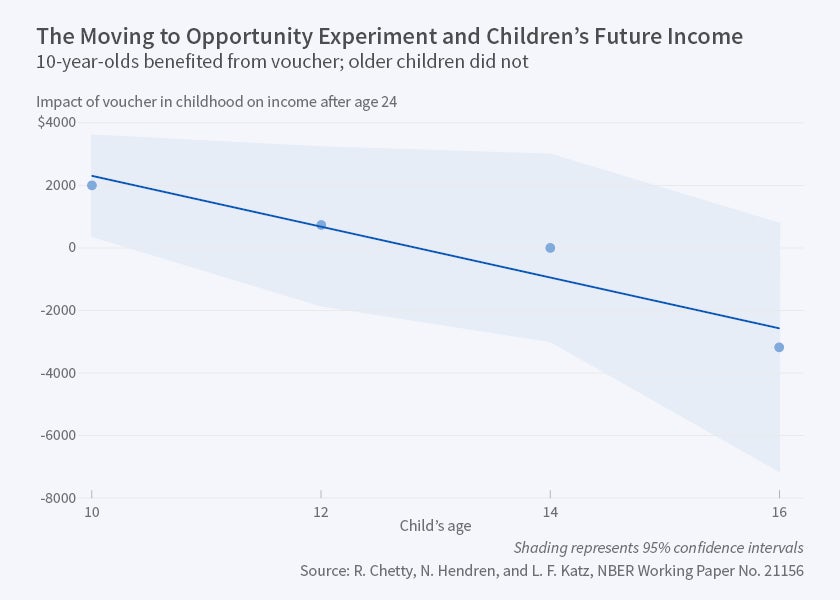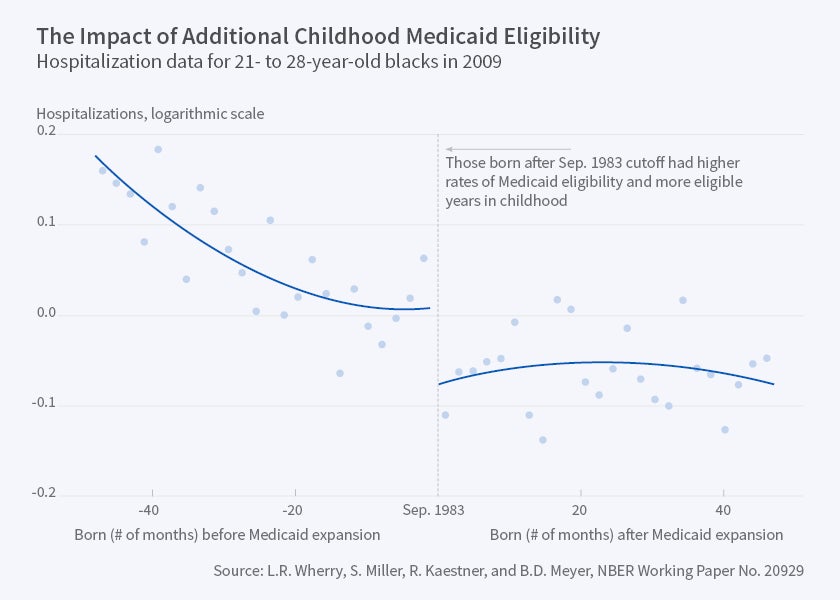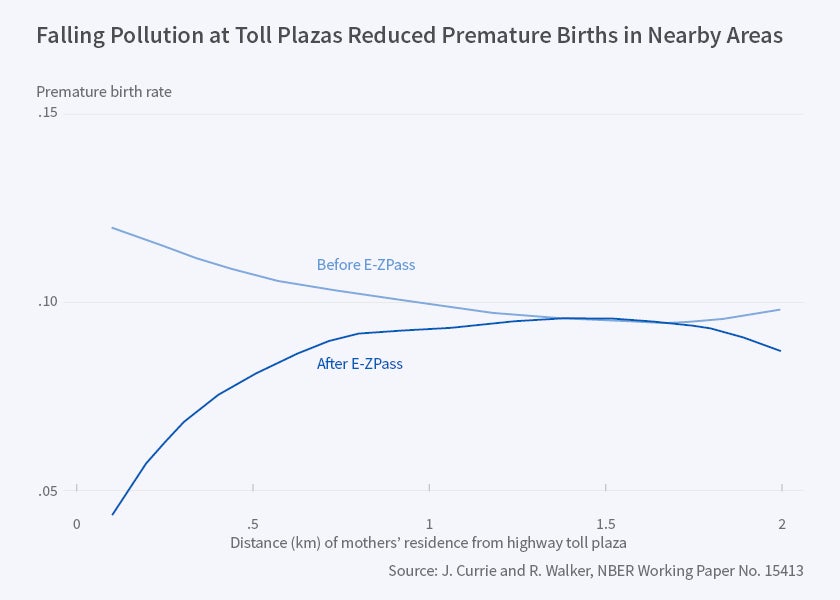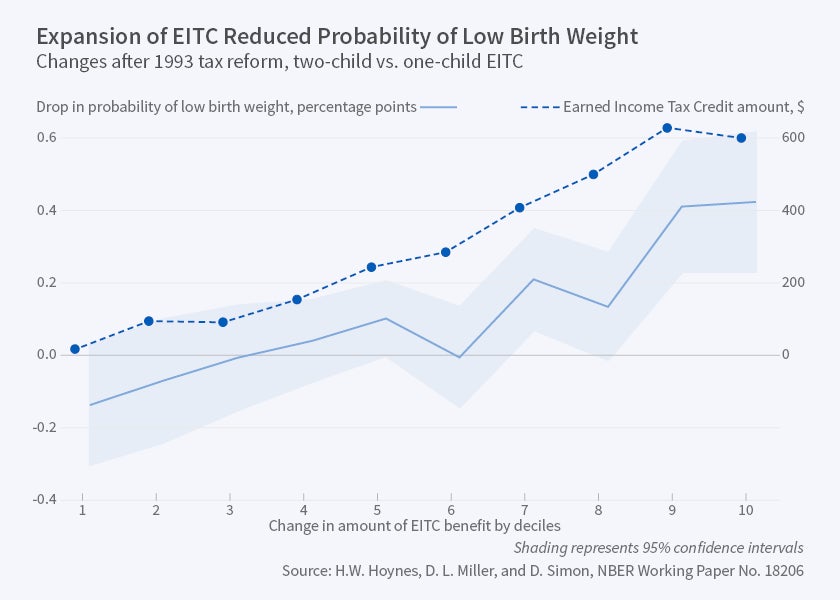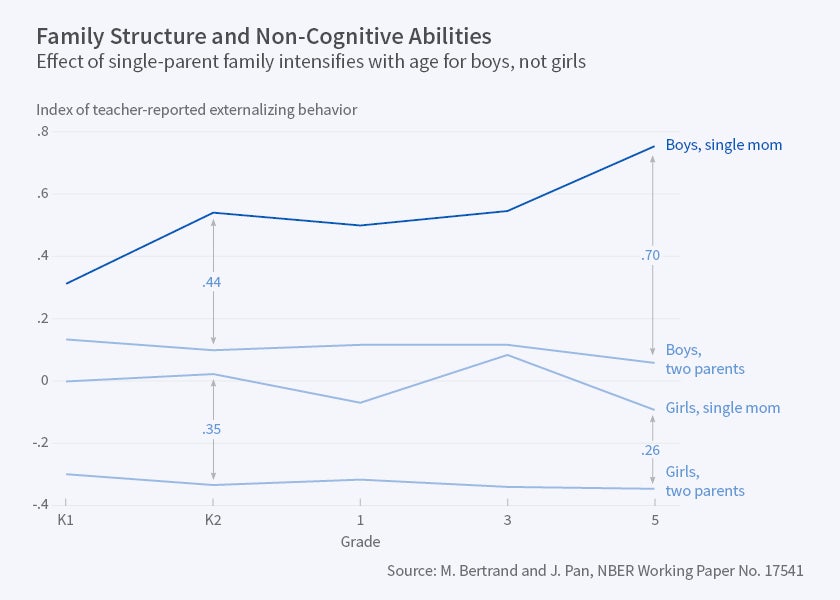Program Report: Children, 2016
U.S. public programs that are targeted to children and youth have grown rapidly in recent decades. This trend has generated a substantial volume of research devoted to program evaluation. At the same time, researchers have developed an expanded conception of human capital and how it develops over the life course. This has drawn attention to children's physical and mental health, as well as to factors such as environmental exposures and maternal stress that influence the development of both non-cognitive and cognitive skills. Researchers in the Program on Children have been active contributors both to the evaluation of programs for children and to our developing understanding of the roots of human capital formation. This review provides a partial summary of this work. The number of research studies in the last eight years unfortunately makes it impossible to discuss all of the relevant contributions.
Long Run Consequences of Conditions in Early Life
The original "fetal origins" hypothesis held that poor nutrition during the fetal period could have persistent effects on metabolism that could lead to adult disease. Economists in the children's group have broadened the scope of inquiry beyond a narrow focus on fetal nutrition to examine factors beyond prenatal nutrition, shocks in early childhood as well as the fetal period, and a much broader array of outcomes. Douglas Almond, Bhashkar Mazumder, and Reyn Van Ewijk show, for example, that nutritional restriction due to Ramadan fasting is associated with lower child test scores at age seven.1 Joseph Ferrie and Karen Rolf show that socioeconomic status in a household when children are ages 0 to five is historically associated with longevity and health in old age [Figure 1].2 David Autor, David Figlio, Krzysztof Karbownik, Jeffrey Roth, and Melanie Wasserman link contemporary birth and schooling records in Florida to show that disadvantaged boys tend to have lower test scores, more disciplinary problems, and less likelihood of completing high school.3 Anna Aizer, Shari Eli, Ferrie, and Adriana Lleras-Muney show that cash transfers to poor families at the early decades of the 20th century led to increases in the income and longevity of children in those households.4 Similarly Fredrik Andersson, John Haltiwanger, Mark Kutzbach, Giordano Palloni, Henry Pollakowski, and Daniel Weinberg show that, once the endogeneity of public housing use is accounted for, childhood residence in supported housing, which has a large cash value, has positive effects on young adult earnings and reduces the probability of incarceration.5 A possible caution: Gordon Dahl, Andreas Ravndal Kostoi, and Magne Mogstad show that family welfare participation can increase the probability that children grow up to participate themselves.6
Neighborhood conditions while young are another important determinant of longer-term outcomes. Jens Ludwig, Greg Duncan, Lisa Gennetian, Lawrence Katz, Ronald Kessler, Jeffrey Kling, and Lisa Sanbonmatsu summarize long-term effects of the Moving to Opportunity experiment, which enabled some poor families to move to less-poor neighborhoods, and find relatively little effect on children in those families.7 However, Raj Chetty, Nathaniel Hendren, and Katz find that the younger children in those families did benefit from moving in terms of higher future incomes [Figure 2].8 Chetty, Hendren, Patrick Kline, and Emmanuel Saez argue that features of neighborhoods that promote social mobility include low residential segregation, less income inequality, better schools, more social capital, and more family stability.9
Many Program on Children researchers document longer-term effects of specific policy initiatives. Hilary Hoynes, Diane Schanzenbach, and Douglas Almond find positive effects of childhood participation in the Food Stamp Program on future adult health, as measured by reductions in rates of high blood pressure, obesity, and diabetes.10 Gabriella Conti, James Heckman, and Rodrigo Pinto find improvements in the adult health of participants in two model preschool programs,11 while Heckman, Pinto, and Peter Savelyev argue that much of this effect is operating through changes in personality traits.12 On a cautionary note, Michael Baker, Jonathan Gruber, and Kevin Milligan find negative effects of a Quebec universal child care program on children's non-cognitive skills, underscoring the importance of program quality.13
Expansions of Medicaid and the Value of Medical Care
One of the most important policies that affected children born in the late 20th century was the expansion of public health insurance under the Medicaid program. State governments were first incentivized and then required to expand coverage to children in poor families, and many states expanded coverage to children with family incomes up to 200 percent of the federal poverty line. Because the expansions occurred at different times in different states and affected some age groups and not others, it is possible to identify the effect of insurance.
Currie, Sandra Decker, and Wanchuan Lin,14 Bruce Meyer and Laura Wherry,15 David Brown, Amanda Kowalski, and Ithai Lurie,16 and Wherry, Sarah Miller, Robert Kaestner, and Meyer17 all examine the long-term effect of these expansions on individuals who gained coverage as young children. They focus on different datasets and find positive effects on diverse young adult outcomes, including maternal reports of health, hospitalization for chronic conditions, and employment and earnings. Figure 3, from Wherry et al. (on the following page), shows the reduction in hospitalizations for chronic conditions among young adults who had Medicaid coverage from early childhood. Those born after September 1, 1983, were covered, whereas those born just before that date were never eligible. Currie and Hannes Schwandt argue that these expansions of access to care may explain some of the large reductions in mortality inequality among children over the past 20 years.18
These findings imply a large positive value for the medical care received at the margin, an inference borne out by Almond, Joseph Doyle, Kowalski, and Heidi Williams who estimate that the statistical cost of saving a very low birth weight's life was about $550,000 in 2006 dollars.19 At the same time, Currie and Bentley MacLeod20 and Erin Johnson and Marit Rehavi21 study the incidence of C-sections, and conclude that many are probably unnecessary.
Stress and Mental Health
Researchers in the Program on Children have moved from focusing only on cognitive skills, to thinking about non-cognitive skills (such as social skills) and physical health, to explicitly studying mental health and its role in promoting positive future outcomes.
Using a sibling fixed effects design, Jason Fletcher examines ADHD, one of the most prevalent childhood mental health conditions and finds large negative impacts on employment, welfare use, and earnings.22 While this finding would seem to argue that treatment of ADHD should have large positive effects, Currie, Mark Stabile, and Lauren Jones find that increases in drug treatment that accompanied an expansion of drug coverage in Quebec had little positive effect on educational outcomes or emotional functioning, suggesting that drug therapy alone may not be enough to improve outcomes.23 Susan Busch, Ezra Golberstein, and Ellen Meara examine the use of antidepressants among adolescents and find that FDA "black box" warnings—the most stringent warnings used in prescription drug labeling—discouraged antidepressant use and led to increases in risky behaviors and small reductions in grade point averages.24 Mark Anderson, Resul Cesur, and Erdal Tekin further argue that depression increases adolescent propensity to engage in property crime, though not violent crime or selling drugs.25 Together these papers suggest that many children suffer from poor mental health and that more research into how it can be treated appropriately is needed.
Acute stress, both among mothers and among children, may be one root cause of poor mental health. Aizer, Laura Stroud, and Stephen Buka exploit unique data on maternal cortisol levels during pregnancy and find, using sibling comparisons, that children exposed to high levels of this "stress hormone" suffer negative effects on their cognitive functioning and motor development.26 Moreover, mothers of lower socioeconomic status have higher cortisol levels, suggesting one mechanism for the intergenerational transmission of poverty. This is consistent with work by William Evans and Craig Garthwaite showing that Earned Income Tax Credit (EITC) payments are associated with improved maternal mental health and reduction of certain biomarkers for stress.27
A source of stress that is more common among mothers of lower socioeconomic status is the death of a family member. Petra Persson and Maya Rossin-Slater compare children whose mothers experienced loss of a family member while the children were in utero to those who experienced such a loss in the first year after birth; they find that the former group were more likely to suffer from mental health problems including ADHD, anxiety, and depression in later life.28 Sandra Black, Paul Devereux, and Kjell Salvanes also investigate the long-term effects of the mother experiencing a death in the family during pregnancy. They find negative effects on birth outcomes, but do not find negative effects on adult outcomes such as education, employment, and earnings.29
Currie and Rossin-Slater examine the effect of maternal residence along the predicted path of a hurricane during pregnancy and find increases in abnormal conditions of the newborn.30 Seth Gershenson and Tekin find that stress due to the "Beltway Sniper" impacted the test scores of children in schools near the locations of the shootings but that the effect dissipated after one year.31 Even more "every day" stress due to poor economic conditions and higher risk of parental job loss is shown by Golberstein, Gilbert Gonzales, and Meara to have negative effects on children's mental health.32
Environmental Policy
Pollution from toxic chemicals like lead can also have important long-term effects on children's health. The combination of large administrative datasets measuring both pollution levels and health outcomes, and environmental policies that have greatly reduced pollution exposures, have allowed us to better identify the harmful effects of exposures. Karen Clay, Joshua Lewis, and Edson Severnini show that emissions from coal-fired electricity generation plants were responsible for 3,500 infant deaths per year in the early 1960s.33 Currie and Reed Walker find that the implementation of E-ZPass improved birth outcomes in the neighborhood of highway toll plazas by reducing pollution from automobiles [Figure 4].34 Adam Isen, Rossin-Slater, and Walker follow children born in counties that were required to reduce air pollution because of the 1970 Clean Air Act. They find that lower pollution levels in the year of birth are associated with higher employment levels and higher earnings at age 30.35 Aizer, Currie, Peter Simon, and Patrick Vivier document the tremendously positive effects of measures to reduce lead exposure by targeting old lead paint in Rhode Island. They show that in areas that implemented a "lead safe" certificate program, preschool blood lead levels declined rapidly and children's later test scores improved.36 This study builds on previous work by Jessica Reyes showing that cohorts of young children who benefited from the elimination of lead in gasoline when they were young had lower levels of behavior problems, aggression, and delinquency as adolescents and less crime as young adults.37 Currie, Lucas Davis, Michael Greenstone, and Walker find that manufacturing plants that emitted toxic pollutants reduced infant health within a one-mile radius.38 Currie, Greenstone, and Enrico Moretti find that Superfund hazardous waste site cleanups improved birth outcomes among infants born to mothers who lived nearby compared to mothers who lived a little further away.39 Claudia Persico, Figlio, and Roth show that children prenatally exposed to Superfund sites are more likely to repeat a grade or be suspended from school and have lower test scores than their own younger siblings who benefited from later cleanups of these sites.40
Additional Immediate or Short-Term Impacts of Policy on Children
In addition to tracking long-term effects, researchers in the Program on Children continue to study the immediate impacts of a wide variety of policies affecting children and their families. These include cash transfer programs, preschool enrichment, and nutrition programs. Hoynes, Douglas Miller, and David Simon show that expansions of the EITC reduced the incidence of low birth weight and that the impact was greatest for African-American mothers [Figure 5].41 In keeping with the finding of heterogeneous program effects, Marianne Bitler, Hoynes, and Thurston Domina estimate quantile treatment effect models of the Head Start preschool program for disadvantaged children and find the largest and most persistent effects on the most disadvantaged children.42 This is consistent with work by Kline and Chris Walters showing that the impact of Head Start is greatest for those children without access to any other preschool programming.43
Sara Markowitz, Kathleen Adams, Patricia Dietz, Viji Kanna, and Van Tong study state increases in cigarette taxes and bans on indoor smoking and show that both policies reduced the rate of premature births.44 Aizer and Stroud show that the initial Surgeon General's report about the dangers of smoking had a much greater impact on smoking among more-educated women, so that initially the gap in smoking rates grew.45
Schanzenbach and Mary Zaki focus on an expansion in the School Breakfast Program and find some evidence of improvements in health and behavior in some subgroups, though not overall.46 Hoynes, Marianne Page, and Ann Huff Stevens focus on the initial roll out of the Supplemental Nutrition for Women, Infants and Children (WIC) Program across U.S. counties and show that it had positive effects on infant health and no evidence that these effects are driven by differences in fertility.47 Currie and Ishita Rajani examine WIC in New York City and find that even comparing siblings born full term, WIC reduces low birth weight.48 John Cawley, David Frisvold, and Chad Meyerhoefer examine state physical education mandates and find that they lower body mass index and reduce the probability of obesity among fifth graders, especially boys.49 Conversely, Patricia Anderson, Kristin Butcher, and Schanzenbach find that schools cut back on physical education in response to "No Child Left Behind" and that this increased the fraction of children who were overweight.50
Fertility and Parental Behaviors
Parental choices, beginning with the choice to have a child or not and under what circumstances, shape every aspects of a child's life. One of the most important demographic changes of the late 20th and early 21st centuries has been the increase in the rate of non-marital childbearing. Not only has the overall rate increased, but Shelly Lundberg, Robert Pollak, and Jenna Stearns document a widening divide between parents with college education and those without in terms of whether they will marry and remain married.51 They argue that college educated parents marry in order to facilitate the increasingly intense investments that they will jointly make in their children. Matthias Doepke and Fabian Kindermann instead emphasize conflict between parents. They present cross-country evidence from 19 nations suggesting that fertility is lower in countries where women bear more of the child care burden.52 Lisa Dettling and Melissa Kearney show that increases in housing prices encourage child bearing among homeowners but discourage it among renters, highlighting the importance of economic factors in fertility decisions.53
Martha Bailey provides a history of the impact of the introduction of federally funded family planning programs for 1964 to 1973 on fertility, linking them to both delays in childbearing and decreases in the number of children per woman.54 Michael Lovenheim, Randall Reback, and Leigh Wedenoja focus on teens and show that school-based health centers can lower teen fertility, especially among younger teens and African Americans.55 Kasey Buckles and Daniel Hungerman show that a condom distribution program is also effective, lowering teen fertility by about 10 percent.56 Jason Lindo and Analisa Packham show that a policy providing long-acting reversible contraceptives to teenagers reduced the teen birth rate by five percent.57 While not a policy per se, the violence inflicted on abortion providers in many parts of the country has had the opposite effect, according to Mireille Jacobson and Heather Royer, increasing fertility by making it more difficult to terminate a pregnancy.58 Two studies by Kearney and Phillip Levine indicate, however, that much of the decline in teen childbearing since 1981 appears due to "demand" factors: Both lower teen employment rates and TV shows depicting the realities of teen motherhood have had large effects on teen birth rates.59
Fertility decisions can have a direct impact on the parental resources available for children, as Chinhu Juhn, Yona Rubinstein, and Andrew Zuppann emphasize in their re-examination of the so-called child quantity-quality tradeoff.60 Black, Devereux, and Salvanes find evidence of complicated patterns of parental investment by birth order, showing for example, that mothers are more likely to be smokers when their first children are born but also are more likely to breast feed those children.61 Marianne Bertrand and Jessica Pan focus on father presence as an important input, showing that boys in "broken" families are more likely to have deficits in non-cognitive skills [Figure 6].62 On the other hand, Lindo, Jessamyn Schaller, and Benjamin Hansen show that higher male unemployment rates predict increases in child abuse and neglect at the county level,63 while Page, Schaller, and Simon find that better maternal employment prospects are associated with worse child health.64 Consistent with this latter finding, Chris Herbst and Tekin find that higher child care subsidies are associated with greater risk of childhood obesity, perhaps through encouraging the use of non-parental care. Parental behaviors may also be implicated in the higher infant mortality rates seen in the U.S. compared to European countries.65 Alice Chen, Emily Oster, and Williams show that the while some of the higher death rate is attributable to poorer health at birth, much of the gap opens up after the first month of life, pointing to conditions in the home as a probable cause.66
Several studies examine ways in which policy can impact parents' investments in children. Alexander Gelber and Isen find that parents who were randomized to Head Start in the Head Start Impact Study invest more in their children subsequently, suggesting either that parents view their own inputs as complementary to preschool or that they learned something from Head Start about how to parent.67 Aizer and Flavio Cunha examine the introduction of the Head Start preschool program, arguing that parents tend to reinforce differences between their children and showing that parents are more likely to invest in children in a way that reinforces differences between children in larger families.68 Roland Fryer, Steven Levitt, and John List find that providing mothers with incentives to engage their children in behaviors known to improve child development is very effective in increasing cognitive achievement in some families, but not others.69 Rossin-Slater and Mariam Wust examine child support enforcement in Denmark and find that higher paternal obligations raise payments but that these gains are partially offset by various behavioral responses.70 In an innovative study, Susan Mayer, Ariel Kalil, Philip Oreopoulos, and Sebastian Gallegos conduct a field experiment designed to increase the time parents spent reading to their children, using behavioral tools such as text reminders, goal setting, and social rewards; they find large positive effects relative to simply providing information about the importance of reading to children.71
Research Focusing on Adolescents
Much about adolescents is predictive of their incipient adult outcomes. It is during adolescence that many risky or antisocial behaviors emerge or increase in frequency and severity, often with long term consequences. Miguel Sarzosa and Sergio Urzua estimate significant long term costs associated with being bullied in one's youth.72 Aizer and Doyle point out that 130,000 juveniles are detained each year. Using randomly assigned judges with different propensities to incarcerate, they find that incarceration in adolescence greatly increases the probability of incarceration in adulthood.73 The importance of mental health is highlighted by Anderson, Cesur, and Tekin who show using school and sibling fixed effects models that adolescent depression predicts future property crime.74 Fletcher finds further that adolescent depression predicts lower employment probabilities later in life.75
While much of the previous work examining the impact of programs or policies that aim to curb risky behaviors among adolescents has not found them to be particularly effective, more recent work suggests that innovative programs can be effective.76 For example, among youths who are involved with the justice system but not incarcerated, Alison Cuellar and Dhaval Dave find that intensive mental health treatments can help to keep youth in school.77 In contrast, adolescent behavior seems to be less responsive to prices and sanctions. Anderson, Hansen, and Daniel Rees examine the impact of medical marijuana laws and find little impact of these laws on teen smoking.78 Likewise, Hansen, Joseph Sabia, and Rees argue that the impact of cigarette taxes on youth smoking has declined over time.79
The close links between mental health, what economists often call non-cognitive skills, cognitive skills, and outcomes are emphasized by two studies reporting on randomized interventions of innovative programs among youth in Chicago. Philip Cook, Kenneth Dodge, George Farkas, Fryer, Jonathan Guryan, Ludwig, Mayer, Harold Pollack, and Laurence Steinbert discuss an intervention designed to improve school performance by combining coaching on social-cognitive skills with personalized academic remediation. While the sample was small and it is not known if the program is scalable, the program had dramatic effects at modest cost.80 Sara Heller, Anuj Shah, Guryan, Ludwig, Sendhil Mullainathan, and Pollack discuss three randomized controlled trials aimed at reducing violence and arrests and improving school engagement. These interventions, which emphasized teaching youth to slow down before acting on first thoughts and automatic behaviors, suggest that it may be possible to intervene effectively with adolescents, as well as with pregnant women and young children, to improve child outcomes.81
Endnotes
D. Almond, B. Mazumder, and R. van Ewijk, "Fasting During Pregnancy and Children's Academic Performance," NBER Working Paper 17713, December 2011.
J. Ferrie and K. Rolf, "Socioeconomic Status in Childhood and Health After Age 70: A New Longitudinal Analysis for the U.S., 1895-2005," NBER Working Paper 17016, May 2011, and Explorations in Economic History, 48(4), 2011, pp. 445-60.
D. Autor, D. Figlio, K. Karbownik, J. Roth, and M. Wasserman, "Family Disadvantage and the Gender Gap in Behavioral and Educational Outcomes," NBER Working Paper 22267, May 2016.
A. Aizer, S. Eli, J. Ferrie, and A. Lleras-Muney, "The Long Term Impact of Cash Transfers to Poor Families," NBER Working Paper 20103, May 2014, and American Economic Review, 106(4), 2016, pp. 935–71.
F. Anderson, J.C. Haltiwanger, M.J. Kutzbach, G.E. Palloni, H.O. Pollakowski, and D. Weinberg, "Childhood Housing and Adult Earnings: A Between-Siblings Analysis of Housing Vouchers and Public Housing," NBER Working Paper 22721, October 2016.
G.B. Dahl, A.R. Kostol and M. Mogstad, "Family Welfare Cultures," NBER Working Paper 19237, July 2013, and The Quarterly Journal of Economics, Oxford University Press, 129(4), 2014, pp. 1711-52.
J. Ludwig, G.J. Duncan, L.A. Gennetian, L.F. Katz, R.C. Kessler, J.R. Kling, and L. Sanbonmatsu, "Long-Term Neighborhood Effects on Low-Income Families: Evidence from Moving to Opportunity," NBER Working Paper 18772, February 2013, and American Economic Review, 103(3), 2013, pp. 226-31.
R. Chetty, N. Hendren, and L.F. Katz, "The Effects of Exposure to Better Neighborhoods on Children: New Evidence from the Moving to Opportunity Experiment," NBER Working Paper 21156, May 2015, and American Economic Review, 106(4), 2016, pp. 855–902.
R. Chetty, N. Hendren, P. Kline, and E. Saez, "Where is the Land of Opportunity? The Geography of Inter-generational Mobility in the United States," NBER Working Paper 19843, January 2014, and The Quarterly Journal of Economics, 129(4), 2014, pp. 1553-623.
H. Hoynes, D.W. Schanzenbach, and D. Almond, "Long Run Impacts of Childhood Access to the Safety Net," NBER Working Paper 18535, November 2012, and American Economic Review, 106(4), 2016, pp. 903-34.
G. Conti, J.J. Heckman, and R. Pinto, "The Effects of Two Influential Early Childhood Interventions on Health and Healthy Behaviors," NBER Working Paper 21454, August 2015.
J.J. Heckman, R. Pinto, and P.A. Savelyev, "Understanding the Mechanisms through Which an Influential Early Childhood Program Boosted Adult Outcomes," NBER Working Paper 18581, November 2012, and American Economic Review, 103(6), 2013, pp. 2052-86.
M. Baker, J. Gruber, and K. Mulligan, "Non-Cognitive Deficits and Young Adult Outcomes: The Long-Run Impacts of a Universal Child Care Program," NBER Working Paper 21571, September 2015.
J. Currie, S. Decker, and W. Lin, "Has Public Health Insurance for Older Children Reduced Disparities in Access to Care and Health Outcomes?" NBER Working Paper 14173, July 2008, and Journal of Health Economics, 27(6), 2008, pp. 1567–81.
B.D. Meyer and L.R. Wherry, "Saving Teens: Using a Policy Discontinuity to Estimate the Effects of Medicaid Eligibility," NBER Working Paper 18309, August 2012.
D.W. Brown, A.E. Kowalski, and I.Z. Lurie, "Medicaid as an Investment in Children: What is the Long-Term Impact on Tax Receipts?" NBER Working Paper 20835, January 2015.
L.R. Wherry, S. Miller, R. Kaestner, and B.D. Meyer, "Childhood Medicaid Coverage and Later Life Health Care Utilization," NBER Working Paper 20929, February 2015.
J. Currie and H. Schwandt, "Mortality Inequality: The Good News from a County-Level Approach," NBER Working Paper 22199, April 2016, and Journal of Economic Perspectives, 30(2), 2016, pp. 29–52.
D. Almond, J.J. Doyle Jr., A.E. Kowalski, and H. Williams, "Estimating Marginal Returns to Medical Care: Evidence from At-Risk Newborns," NBER Working Paper 14522, December 2008, and Quarterly Journal of Economics, 125(2), 2010, pp. 591–634.
J. Currie and W.B. MacLeod, "Diagnosing Expertise: Human Capital, Decision Making and Performance Among Physicians," NBER Working Paper 18977, April 2013.
E.M. Johnson and M.M. Rehavi, "Physicians Treating Physicians: Information and Incentives in Child-birth," NBER Working Paper 19242, July 2013, and American Economic Journal: Economic Policy, 8(1), 2016, pp. 115-41.
J. Fletcher, "The Effects of Childhood ADHD on Adult Labor Market Outcomes," NBER Working Paper 18689, January 2013, and Health Economics, 23(2), 2014, pp. 159-81.
J. Currie, M. Stabile, and L.E. Jones, "Do Stimulant Medications Improve Educational and Behavioral Outcomes for Children with ADHD?" NBER Working Paper 19105, June 2013, and Journal of Health Economics, 37, 2014, pp. 58-69.
S. Busch, E. Goldberstein, and E. Meara, "The FDA and ABCs: The Unintended Consequences of Antidepressant Warnings on Human Capital," NBER Working Paper 17426, September 2011, and Journal of Human Resources, 49(3), 2014, pp. 540-71.
D.M. Anderson, R. Cesur, and E. Tekin, "Youth Depression and Future Criminal Behavior," NBER Working Paper 18656, December 2012, and Economic Inquiry, 53(1), 2015, pp. 294-317
A. Aizer, L. Stroud, and S. Buka, "Maternal Stress and Child Outcomes: Evidence from Siblings," NBER Working Paper 18422, September 2012.
W.N. Evans and C.L. Garthwaite, "Giving Mom a Break: The Impact of Higher EITC Payments on Maternal Health," NBER Working Paper 16296, August 2010, and American Economic Journal, 6(2), 2014, pp. 258-90.
P. Persson and M. Rossin-Slater, "Family Ruptures, Stress, and the Mental Health of the Next Generation," NBER Working Paper 22229, May 2016.
S. Black, P.J. Devereux, and K. Salvanes, "Does Grief Transfer across Generations? In-Utero Deaths and Child Outcomes," NBER Working Paper 19979, March 2014.
J. Currie and M. Rossin-Slater, "Weathering the Storm: Hurricanes and Birth Outcomes," NBER Working Paper 18070, May 2012, and Journal of Health Economics, 32(2), 2013, pp. 487–503.
S. Gershenson and E. Tekin, "The Effect of Community Traumatic Events on Student Achievement: Evidence from the Beltway Sniper Attacks," NBER Working Paper 21055, March 2015.
E. Goldberstein, G. Gonzales, and E. Meara, "Economic Conditions and Children's Mental Health," NBER Working Paper 22459, July 2016.
K. Clay, J. Lewis, and E. Severnini, "Canary in a Coal Mine: Infant Mortality, Property Values, and Tradeoffs Associated with Mid-20th Century Air Pollution," NBER Working Paper 22155, April 2016.
J. Currie and W.R. Walker, "Traffic Congestion and Infant Health: Evidence from E-ZPass," NBER Working Paper 15413, October 2009, and American Economic Journal: Applied Economics, 3(1), 2011, pp. 65–90.
A. Isen, M. Rossin-Slater, and W.R. Walker, "Every Breath You Take - Every Dollar You'll Make: The Long-Term Consequences of the Clean Air Act of 1970," NBER Working Paper 19858, January 2014.
A. Aizer, J. Currie, P. Simon, and P. Vivier, "Do Low Levels of Blood Lead Reduce Children's Future Test Scores?" NBER Working Paper 22558, August 2016.
J.W. Reyes, "Lead Exposure and Behavior: Effects on Antisocial and Risky Behavior among Children and Adolescents," NBER Working Paper 20366, August 2014, and Economic Inquiry, 53(3), 2015, pp. 1580-1605.
J. Currie, L. Davis, M. Greenstone and W.R. Walker, "Do Housing Prices Reflect Environmental Health Risks? Evidence from More than 1600 Toxic Plant Openings and Closings," NBER Working Paper 18700, January 2013, and American Economic Review, 105(2), 2015, pp. 678-709.
J. Currie, M. Greenstone, and E. Moretti, "Superfund Cleanups and Infant Health," NBER Working Paper 16844, March 2011, and American Economic Review, 101(3), 2011, pp. 435-41.
C. Persico, D. Figlio, and J. Roth, "Inequality Before Birth: The Developmental Consequences of Environmental Toxicants," NBER Working Paper 22263, May 2016.
H. Hoynes, D.L. Miller, and D. Simon, "Income, the Earned Income Tax Credit, and Infant Health," NBER Working Paper 18206, July 2012, and American Economic Journal: Economic Policy, 7(1), 2015, pp. 172-211.
M.P. Bitler, H. Hoynes, and T. Domina, "Experimental Evidence on Distributional Effects of Head Start," NBER Working Paper 20434, August 2014.
P. Kline and C. Walters, "Evaluating Public Programs with Close Substitutes: The Case of Head Start," NBER Working Paper 21658, October 2015.
S. Markowitz, E.K. Adams, P.M. Dietz, V. Kannan, and V. Tong, "Smoking Policies and Birth Outcomes: Estimates From a New Era," NBER Working Paper 17160, June 2011.
A. Aizer and L. Stroud, "Education, Knowledge and the Evolution of Disparities in Health," NBER Working Paper 15840, March 2010.
D.W. Schanzenbach and M. Zaki, "Expanding the School Breakfast Program: Impacts on Children's Consumption, Nutrition and Health," NBER Working Paper 20308, July 2014.
H. Hoyes, M. Page and A. Huff Stevens, "Is a WIC Start a Better Start? Evaluating WIC's Impact on Infant Health Using Program Introduction," NBER Working Paper 15589, December 2009, and Journal of Public Economics, 95, 2011, pp. 813–27.
J. Currie and I. Rajani, "Within-Mother Estimates of the Effects of WIC on Birth Outcomes in New York City," NBER Working Paper 20400, August 2014, and Economic Inquiry, 53(4), 2015, pp. 1691–1701.
J. Cawley, D. Frisvold, and C. Meyerhoefer, "The Impact of Physical Education on Obesity among Elementary School Children," NBER Working Paper 18341, August 2012, and Journal of Health Economics, 32(4), 2013, pp. 743–55.
P.M. Anderson, K.F. Butcher, and D.W. Schanzenbach, "Adequate (or Adipose?) Yearly Progress: Assessing the Effect of 'No Child Left Behind' on Children's Obesity," NBER Working Paper 16873, March 2011.
S. Lundberg, R.A. Pollak, and J.E. Stearns, "Family Inequality: Diverging Patterns in Marriage, Cohabitation, and Childbearing," NBER Working Paper 22078, March 2016, and Journal of Economic Perspectives, 30(2), 2016, pp. 79-102.
M. Doepke and F. Kindermann, "Bargaining over Babies: Theory, Evidence, and Policy Implications," NBER Working Paper 22072, March 2016.
L.J. Dettling and M.S. Schettini Kearney, "House Prices and Birth Rates: The Impact of the Real Estate Market on the Decision to Have a Baby," NBER Working Paper 17485, October 2011, and Journal of Public Economics, 110, 2014, pp. 1–116.
M. Bailey, "Reexamining the Impact of Family Planning Programs on U.S. Fertility: Evidence from the War on Poverty and the Early Years of Title X," NBER Working Paper 17343, August 2011, and American Economic Journal: Applied Economics, 4(2), 2012, pp. 62-97; also M. Bailey, "Fifty Years of Family Planning: New Evidence on the Long-Run Effects of Increasing Access to Contraception," NBER Working Paper 19493, October 2013, and Brookings Papers on Economic Activity, 46(1), 2013, pp.341-409.
M.F. Lovenheim, R. Reback, and L. Wedenoja, "How Does Access to Health Care Affect Teen Fertility and High School Dropout Rates? Evidence from School-based Health Centers," NBER Working Paper 22030, February 2016.
K.S. Buckles and D.M. Hungerman, "The Incidental Fertility Effects of School Condom Distribution Programs," NBER Working Paper 22322, June 2016.
J.M. Lindo and A. Packham, "How Much Can Expanding Access to Long-Acting Reversible Contraceptives Reduce Teen Birth Rates?" NBER Working Paper 21275, June 2015.
M. Jacobson and H. Royer, "Aftershocks: The Impact of Clinic Violence on Abortion Services," NBER Working Paper 16603, December 2010, and American Economic Journal: Applied Economics, 3(1), 2011, pp. 189-223.
M.S. Kearney and P.B. Levine, "Explaining Recent Trends in the U.S. Teen Birth Rate," NBER Working Paper 17964, March 2012; also M.S. Kearney and P.B. Levine, "Media Influences on Social Out-comes: The Impact of MTV's 16 and Pregnant on Teen Childbearing," NBER Working Paper 19795, January 2014, and American Economic Review, 105(12), 2015, pp. 3597-632.
C. Juhn, Y. Rubinstein, and A. Zuppann, "The Quantity-Quality Trade-off and the Formation of Cognitive and Non-cognitive Skills," NBER Working Paper 21824, December 2015.
S. Black, P.J. Devereux, and K. Salvanes, "Healthy(?), Wealthy and Wise: Birth Order and Adult Health," NBER Working Paper 21337, July 2015.
M. Bertrand and J. Pan, "The Trouble with Boys: Social Influences and the Gender Gap in Disruptive Behavior," NBER Working Paper 17541, October 2011, and American Economic Journal: Applied Economics, 5(1), 2013, pp. 32-64.
J.M. Lindo, J. Schaller, and B. Hansen, "Caution! Men Not at Work: Gender-Specific Labor Market Conditions and Child Maltreatment," NBER Working Paper 18994, April 2013.
M. Page, J. Schaller and D. Simon, "The Effects of Aggregate and Gender-Specific Labor Demand Shocks on Child Health," NBER Working Paper 22394, July 2016.
C. Herbst and E. Tekin, "Child Care Subsidies and Childhood Obesity," NBER Working Paper 15007, May 2009, and Review of Economics of the Household, 9(3), 2011, pp. 349-78.
A. Chen, E. Oster, and H. Williams, "Why is Infant Mortality Higher in the US than in Europe?" NBER Working Paper 20525, September 2014.
A. Gelber and A. Isen, "Children's Schooling and Parents' Investment in Children: Evidence from the Head Start Impact Study," NBER Working Paper 17704, December 2011, and Journal of Public Economics, 101, 2013, pp. 25-38.
A. Aizer and F. Cunha, "The Production of Human Capital: Endowments, Investments and Fertility," NBER Working Paper 18429, September 2012.
R. Fryer, S. Levitt and J. List, "Parental Incentives and Early Childhood Achievement: A Field Experiment in Chicago Heights," NBER Working Paper 21477, August 2015.
M. Rossin-Slater and M. Wust, "Parental Responses to Child Support Obligations: Evidence from Administrative Data," NBER Working Paper 22227, May 2016.
S. Mayer, A. Kalil, P. Oreopoulos, and S. Gallegos, "Using Behavioral Insights to Increase Parental Engagement: The Parents and Children Together (PACT) Intervention," NBER Working Paper 21602, October 2015.
M. Sarzosa and S. Urzua, "Bullying among Adolescents: The Role of Cognitive and Non-Cognitive Skills," NBER Working Paper 21631, October 2015.
A. Aizer and J.J. Doyle Jr., "Juvenile Incarceration, Human Capital and Future Crime: Evidence from Randomly-Assigned Judges," NBER Working Paper 19102, June 2013, and The Quarterly Journal of Economics, 130(2), 2015, pp. 759-803.
D.M. Anderson, R. Cesur, and E. Tekin, "Youth Depression and Future Criminal Behavior," NBER Working Paper 18565, December 2012, and Economic Inquiry, 53(1), 2015, pp. 294-317.
J. Fletcher, "Adolescent Depression and Adult Labor Market Outcomes," NBER Working Paper 18216, July 2012, and Southern Economic Journal, 80(1), 2013, pp. 26-49.
J.J. Heckman and T. Kautz, "Fostering and Measuring Skills: Interventions that Improve Character and Cognition," NBER Working Paper 19656, November 2013.
A. Cuellar and D.M. Dave, "Causal Effects of Mental Health Treatment on Education Outcomes for Youth in the Justice System," NBER Working Paper 21206, May 2015, and Economics Education Review, 2016.
D.M. Anderson, B. Hansen, and D. Rees, "Medical Marijuana Laws and Teen Marijuana Use," NBER Working Paper 20332, July 2014, and American Law and Economics Review, 17(2), 2015, pp. 495-528.
B. Hansen, J. Sabia, and D. Rees, "Cigarette Taxes and Youth Smoking: Updated Estimates Using YRBS Data," NBER Working Paper 21311, June 2015.
P. Cook, K. Dodge, G. Farkas, R. Fryer, Jr., J. Guryan, J. Ludwig, S. Meyer, H. Pollack, and L. Steinberg, "The (Surprising) Efficacy of Academic and Behavioral Intervention with Disadvantaged Youth: Results from a Randomized Experiment in Chicago," NBER Working Paper 19862, January 2014.
S. Heller, A. Shah, J. Guryan, J. Ludwig, S. Mullainathan, and H. Pollack, "Thinking, Fast and Slow? Some Field Experiments to Reduce Crime and Dropout in Chicago," NBER Working Paper 21178, May 2015.
